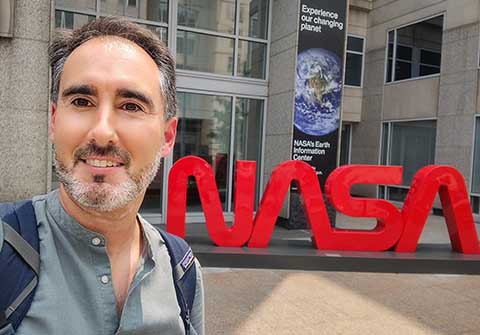Modeling the Impacts of Eclipses in the Ionosphere
Dr. Miguel Martinez Ledesma
Research Scientist
Physics Department, The Catholic University of America
NASA Goddard Space Flight Center
Wed, November 29, 2023 - 4:00 PM
 Solar eclipses are fascinating astronomical events that generate a large reduction of the incident solar irradiation along their obscuration path. Aside of the amazing observing features of eclipses, this solar irradiation reduction modifies the different terrestrial atmospheric layers. In particular, large modifications are observed at the ionospheric layers during solar eclipses. Soon, two solar eclipses will traverse the American region in just over a year, the partial solar eclipse of October 14, 2023 and the total solar eclipse of April 8, 2024. These events will provide an extremely interesting insight on the variability of our ionosphere and its multiple interconnections.
Solar eclipses are fascinating astronomical events that generate a large reduction of the incident solar irradiation along their obscuration path. Aside of the amazing observing features of eclipses, this solar irradiation reduction modifies the different terrestrial atmospheric layers. In particular, large modifications are observed at the ionospheric layers during solar eclipses. Soon, two solar eclipses will traverse the American region in just over a year, the partial solar eclipse of October 14, 2023 and the total solar eclipse of April 8, 2024. These events will provide an extremely interesting insight on the variability of our ionosphere and its multiple interconnections.
During those extraordinary events, the gradual shadowing of the Moon blocks the main source of ionization production in a predictable manner, producing a large scale experiment that provides us relevant information of the ionospheric characteristics and dynamics. Nevertheless, the radiation reduction of an eclipse has different effects on the different layers of the ionosphere located at distinct altitudes. Moreover, ionospheric responses are also highly dependent on the eclipse geometry, the geomagnetic latitude, its previous status, the plasma electrodynamics, and external forcing (such as space weather activity or lower atmospheric interactions). Additionally, eclipse effects can be also measured at conjugate magnetic latitudes (located in the opposite hemisphere) due to plasma interconnections along magnetic field lines. These multiple modifications are extremely dynamic and require of ionospheric models to fully represent the eclipse impacts.
In this presentation, we will present simulation results from the modeling analysis of the eclipses obtained with the Sheffield University Plasmasphere Ionosphere Model (SUPIM) adapted at the Instituto Nacional de Pesquisas Espaciais (INPE). Additionally, simulation results of previous eclipses are compared with measurements obtained from multiple instruments located along the continent.
Refreshments served at 3:45 PM
If you have any questions about the Colloquium Series or would like to make a donation please contact the Physics Department, cua-physics@cua.edu or (202) 319-5315.
